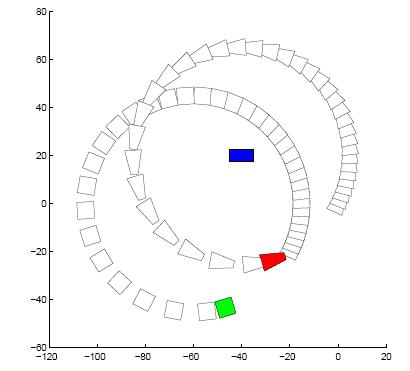Formation State Estimation and Control: Difference between revisions
No edit summary |
|||
| Line 1: | Line 1: | ||
Multi-robot formation feasibility, formation control and formation state estimation have been subject of research at the ISLab since | Multi-robot formation feasibility, formation control and formation state estimation have been subject of research at the ISLab since 2000. | ||
== Obstacle Compliant Formation Control == | |||
We developed a method of controlling a formation of holonomic or non- | |||
holonomic vehicles with a given geometry, compliant with nearby obstacles | |||
(including those represented by teammates). The vehicles are virtually | |||
linked to each other by the influence of artificial potentials that asymptotically | |||
stabilize the formation and keep all the robots separated by specified distances. A | |||
leader selected from the team, or a virtual reference point, is used to guide the team | |||
of autonomous vehicles throughout an area scattered with obstacles. Each vehicle | |||
has access to the positions of all its teammates, and senses the obstacles within a | |||
limited range of its neighborhood. All robots will try to maintain the specified | |||
distance to the leader by using attractive potentials, while avoiding collisions | |||
among themselves and obstacles, by using repulsive potentials. To avoid falling | |||
in local minima of the potential fields, the vehicles will recall the n latest positions | |||
of the leader and use this information to move around the obstacle and keep the | |||
formation. | |||
=== References === | |||
* [http://welcome.isr.ist.utl.pt/img/pdfs/1860_Tese%20Final.pdf Pedro Fazenda's PhD thesis] | |||
== Formation Feasibility == | == Formation Feasibility == | ||
Revision as of 17:55, 14 November 2008
Multi-robot formation feasibility, formation control and formation state estimation have been subject of research at the ISLab since 2000.
Obstacle Compliant Formation Control
We developed a method of controlling a formation of holonomic or non- holonomic vehicles with a given geometry, compliant with nearby obstacles (including those represented by teammates). The vehicles are virtually linked to each other by the influence of artificial potentials that asymptotically stabilize the formation and keep all the robots separated by specified distances. A leader selected from the team, or a virtual reference point, is used to guide the team of autonomous vehicles throughout an area scattered with obstacles. Each vehicle has access to the positions of all its teammates, and senses the obstacles within a limited range of its neighborhood. All robots will try to maintain the specified distance to the leader by using attractive potentials, while avoiding collisions among themselves and obstacles, by using repulsive potentials. To avoid falling in local minima of the potential fields, the vehicles will recall the n latest positions of the leader and use this information to move around the obstacle and keep the formation.
References
Formation Feasibility
We developed a systematic framework for studying formation motion feasibility of multiagent systems. Algebraic conditions that guarantee formation feasibility (i.e., that the specified geometric constraints can be staisfied) given the individual robot kinematics were determined. Our framework also enables us to obtain lower dimensional control systems describing the group kinematics while maintaining all formation constraints.
References
- P. Tabuada, G. J. Pappas, P. U. Lima, "Motion Feasibility of Multi-Agent Formations", IEEE Transactions on Robotics, Vol. 21 (3), pp. 387-392, 2005
- P. Tabuada, G. J. Pappas, P. U. Lima, "Feasible Formations of Multi-Agent Systems", Proc. ACC2001 - American Control Conference, Arlington, VA, USA, 2001 - finalist of Best Student Paper Award
- Paulo Tabuada's PhD thesis
